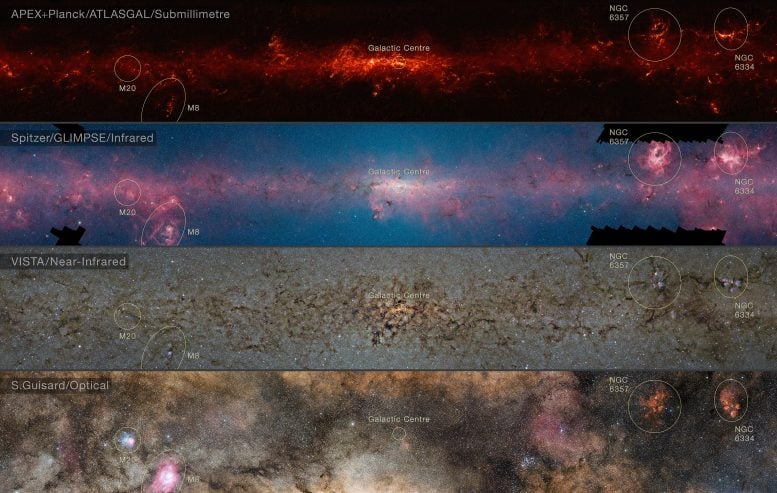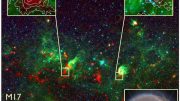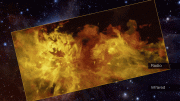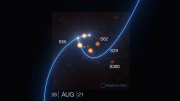
This image reveals the central plane of the Milky Way as seen by ESA’s Planck satellite and the Atacama Pathfinder Experiment (APEX), which is located at an altitude of around 5100m in the Chilean Andes and operated by the European Southern Observatory. Credit: ESO/ATLASGAL consortium; ESA/Planck
At first glance, this image may resemble red ink filtering through water or a crackling stream of electricity, but it is actually a unique view of our cosmic home. It reveals the central plane of the Milky Way as seen by ESA’s Planck satellite and the Atacama Pathfinder Experiment (APEX), which is located at an altitude of around 5100m (16,700 feet) in the Chilean Andes and operated by the European Southern Observatory.
This image was released in 2016 as the final product of an APEX survey mapping the galactic plane visible from the southern hemisphere at submillimeter wavelengths (between infrared and radio on the electromagnetic spectrum). It complements previous data from ESA’s Planck and Herschel space observatories.
Planck and APEX are an ideal pairing. APEX is best at viewing small patches of sky in great detail while Planck data is ideal for studying areas of sky at the largest scales. It covers the entire sky – no mean feat. The two work together well, and offer a unique perspective on the sky.
This image reveals numerous objects within our galaxy. The bright pockets scattered along the Milky Way’s plane in this view are compact sources of submillimeter radiation: very cold, clumpy, dusty regions that may shed light on myriad topics all the way from how individual stars form to how the entire Universe is structured.

This comparison shows the central regions of the Milky Way observed at different wavelengths.
The top panel shows compact sources of submillimeter radiation detected by APEX as part of the ATLASGAL survey, combined with complementary data from ESA’s Planck satellite, to capture more extended features.
The second panel shows the same region as seen in shorter, infrared, wavelengths by the NASA Spitzer Space Telescope.
The third panel shows the same part of sky again at even shorter wavelengths, the near-infrared, as seen by ESO’s VISTA infrared survey telescope at the Paranal Observatory in Chile. Regions appearing as dark dust tendrils here show up brightly in the ATLASGAL view.
Finally the bottom picture shows the more familiar view in visible light, where most of the more distant structures are hidden from view.
Credit: ESO/ATLASGAL consortium/NASA/GLIMPSE consortium/VVV Survey/ESA/Planck/D. Minniti/S. Guisard
Acknowledgement: Ignacio Toledo, Martin Kornmesser, Mahdi Zamani
From right to left, notable sources include NGC 6334 (the rightmost bright patch), NGC 6357 (just to the left of NGC 6334), the galactic core itself (the central, most extended, and brightest patch in this image), M8 (the bright lane branching from the plane to the bottom left), and M20 (visible to the upper left of M8). A labeled view can be seen above.
Planck was launched on 14 May 2009 and concluded its mission in October 2013. The telescope returned a wealth of information about the cosmos; its main aim was to study the Cosmic Microwave Background (CMB), the relic radiation from the Big Bang. Among other milestones, Planck produced an all-sky map of the CMB at incredible sensitivity and precision, and took the ‘magnetic fingerprint’ of the Milky Way by exploring the behavior of certain light emitted by dust within our galaxy.
Its observations are helping scientists to explore and understand how the Universe formed, its composition and contents, and how it has evolved from its birth to present day.
APEX is a collaboration between the Max Planck Institute for Radio Astronomy, the Onsala Space Observatory, and the European Southern Observatory, ESO. The telescope is operated by ESO.








Be the first to comment on "ESA Image of the Week – The Heart of the Milky Way"